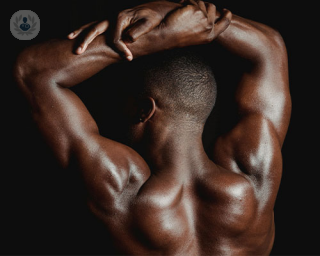What is shoulder surgery?
Shoulder surgery treats injured shoulders by repairing the muscles, connective tissue, or damaged joints that occur from traumatic injury, or from where the shoulder has been overused.
The shoulder is the most flexible joint in the body, allowing the arm to be placed and rotated in many positions in front, above, to the side and behind the body. This degree of movement makes the shoulder susceptible to injury.

Shoulder problems that require surgery
- Bursitis or tendinitis
The rotator cuff can cause pain in many different ways, which includes tendonitis, bursitis or mechanical impingement. These are due to repetitive activities such as swimming or weightlifting. The repetition causes rubbing or squeezing of the rotator cuff under the acromion and in the acromioclavicular joint.
- Impingement
This occurs when the top of the shoulder blade puts pressure on the underlying soft tissues when lifting the arm away from the body. Symptoms of impingement include difficulty reaching up behind the back, pain when using the arm over the head and weakness in shoulder muscles.
- Full-thickness rotator cuff tears
Full-thickness rotator cuff tears are often the result of shoulder impingement, partial thickness rotator cuff tears, or heavy lifting and falls. Rotator cuff tears may involve the entire thickness of the tendon or they may be incomplete, which is known as partial thickness. Rotator cuff surgery and rehabilitation allows patients to regain the lost function in shoulders with cuff disease.
- Instability
One of the shoulder joints is forced out of its normal position. This condition can result in a dislocated shoulder. Patients will experience pain when they raise an arm and it may also feel like their shoulder is out of place.
Diagnosis of a shoulder injury
The doctor will discuss the medical history of the patient and then examine the shoulder. They will check to see whether it is tender in any area and whether there is a deformity. The strength of the arm will also be tested, and the arm will be moved in different directions. Other tests that help with diagnosis include imaging tests, X-rays and MRI scans.
Non-surgical treatment of shoulder injuries
An orthopaedic surgeon will explain certain exercises that are aimed to strengthen the shoulder muscles, which will include wall push-ups and shoulder press-ups. They may also prescribe anti-inflammatory medication.
Surgical treatment for shoulder injuries
- All-arthroscopy repair – this allows the surgeon to insert a thin device with a small lens into tiny incisions to look inside the joint. The images are relayed onto a television screen, allowing the doctor to be guided and make a diagnosis.
- Open repair – in some cases, open repair surgery is necessary. It is done through small incisions, which are only a few inches and required if the tear is large. It is a good option if the tear is complex or if additional reconstruction, such as tendon transfer, is required.
Shoulder surgery
Mr Andreas Baumann - Orthopaedic surgery
Created on: 12-03-2013
Updated on: 06-29-2023
Edited by: Carlota Pano
What is shoulder surgery?
Shoulder surgery treats injured shoulders by repairing the muscles, connective tissue, or damaged joints that occur from traumatic injury, or from where the shoulder has been overused.
The shoulder is the most flexible joint in the body, allowing the arm to be placed and rotated in many positions in front, above, to the side and behind the body. This degree of movement makes the shoulder susceptible to injury.

Shoulder problems that require surgery
- Bursitis or tendinitis
The rotator cuff can cause pain in many different ways, which includes tendonitis, bursitis or mechanical impingement. These are due to repetitive activities such as swimming or weightlifting. The repetition causes rubbing or squeezing of the rotator cuff under the acromion and in the acromioclavicular joint.
- Impingement
This occurs when the top of the shoulder blade puts pressure on the underlying soft tissues when lifting the arm away from the body. Symptoms of impingement include difficulty reaching up behind the back, pain when using the arm over the head and weakness in shoulder muscles.
- Full-thickness rotator cuff tears
Full-thickness rotator cuff tears are often the result of shoulder impingement, partial thickness rotator cuff tears, or heavy lifting and falls. Rotator cuff tears may involve the entire thickness of the tendon or they may be incomplete, which is known as partial thickness. Rotator cuff surgery and rehabilitation allows patients to regain the lost function in shoulders with cuff disease.
- Instability
One of the shoulder joints is forced out of its normal position. This condition can result in a dislocated shoulder. Patients will experience pain when they raise an arm and it may also feel like their shoulder is out of place.
Diagnosis of a shoulder injury
The doctor will discuss the medical history of the patient and then examine the shoulder. They will check to see whether it is tender in any area and whether there is a deformity. The strength of the arm will also be tested, and the arm will be moved in different directions. Other tests that help with diagnosis include imaging tests, X-rays and MRI scans.
Non-surgical treatment of shoulder injuries
An orthopaedic surgeon will explain certain exercises that are aimed to strengthen the shoulder muscles, which will include wall push-ups and shoulder press-ups. They may also prescribe anti-inflammatory medication.
Surgical treatment for shoulder injuries
- All-arthroscopy repair – this allows the surgeon to insert a thin device with a small lens into tiny incisions to look inside the joint. The images are relayed onto a television screen, allowing the doctor to be guided and make a diagnosis.
- Open repair – in some cases, open repair surgery is necessary. It is done through small incisions, which are only a few inches and required if the tear is large. It is a good option if the tear is complex or if additional reconstruction, such as tendon transfer, is required.


When you can't shrug it off: all about shoulder surgery
By Mr John Scadden
2024-12-21
Shoulders are used in a variety of ways – for balance, for support, carrying and throwing, and hugging our loved ones. But shoulders can get damaged due to injury, inflammation, wear and tear, or infection. In this article, Mr John Scadden, leading orthopaedic surgeon, describes different types of shoulder ailments, and the surgeries that correct them. See more


Shoulder dislocations in contact sports and how they affect younger athletes
By Mr Andrew Chambler
2024-12-21
Shoulder dislocations are a common injury among younger athletes who participate in contact sports. Understanding the causes, implications, and management of shoulder dislocations is crucial for athletes, coaches, and healthcare providers to ensure effective treatment and prevention strategies. Leading consultant orthopaedic surgeon Mr Andrew Chambler provides a detailed insight to this, in this informative article. See more


What can be done for shoulder arthritis?
By Mr Mark Falworth
2024-12-20
There are several different types of shoulder arthritis, with the most common being osteoarthritis. Leading orthopaedic surgeon Mr Mark Falworth discusses the different treatment options for those who suffer from shoulder joint pain and arthritis... See more


A shoulder to lean on: recovering from a shoulder fracture
By Mr Charles Jeremy S Corbin
2024-12-20
Shoulder fracture rehabilitation can be painful and long. It doesn't need to be this way, however, and healing can effective with encouragement and the right medical assistance. Leading consultant trauma and orthopaedic surgeon Mr Charles Jeremy Corbin speaks to Top Doctors exactly how to put these factors into place to ensure a successful recovery. See more
Experts in Shoulder surgery
-
Mr Simon Lambert
Orthopaedic surgeryExpert in:
- Arthritis
- Shoulder instability
- Rotator cuff surgery
- Rotator cuff injury
- Shoulder surgery
- Shoulder replacement
-
Mr Steven Corbett
Orthopaedic surgeryExpert in:
- Sports surgery
- Sports traumatology
- Sports injuries
- Shoulder surgery
- Elbow Pain
- Elbow arthroscopy
-
Mr Nashat Siddiqui
Orthopaedic surgeryExpert in:
- Shoulder surgery
- Elbow
- Hand
- Sports injuries
- Wrist fracture
- Muscle injuries
-
Mr Ali Al-Sabti
Orthopaedic surgeryExpert in:
- Shoulder arthroscopy
- Rotator cuff surgery
- Rotator cuff injury
- Arthroscopic subacromial decompression
- Shoulder replacement
- Shoulder surgery
-
Mr Mark Falworth
Orthopaedic surgeryExpert in:
- Shoulder arthroscopy
- Shoulder replacement
- Elbow replacement
- Shoulder surgery
- Shoulder dislocation
- Rotator cuff surgery
- See all

The Princess Grace Hospital - part of HCA Healthcare
The Princess Grace Hospital - part of HCA Healthcare
The Princess Grace Hospital, 42-52 Nottingham Pl, W1U 5NY
No existe teléfono en el centro.
By using the telephone number provided by TOP DOCTORS, you automatically agree to let us use your phone number for statistical and commercial purposes. For further information, read our Privacy Policy
Top Doctors

The Parkside Suite Frimley
The Parkside Suite Frimley
Frimley Park Hospital, Portsmouth Road, GU16 7UJ
No existe teléfono en el centro.
By using the telephone number provided by TOP DOCTORS, you automatically agree to let us use your phone number for statistical and commercial purposes. For further information, read our Privacy Policy
Top Doctors

OneWelbeck Orthopaedics & Sports Medicine
OneWelbeck Orthopaedics & Sports Medicine
1 Welbeck St, London, W1G 0AR
No existe teléfono en el centro.
By using the telephone number provided by TOP DOCTORS, you automatically agree to let us use your phone number for statistical and commercial purposes. For further information, read our Privacy Policy
Top Doctors
-
The Princess Grace Hospital - part of HCA Healthcare
The Princess Grace Hospital, 42-52 Nottingham Pl, W1U 5NY, Central LondonExpert in:
- Cancer
- General Surgery
- Orthopaedic surgery
- Robotic Surgery
- Intensive care
- Sports Medicine
-
The Parkside Suite Frimley
Frimley Park Hospital, Portsmouth Road, GU16 7UJ, CamberleyExpert in:
- Cardiology
- Orthopaedic surgery
- Breast augmentation
- Dermatology
- Endocrinology
- Gastroenterology
-
OneWelbeck Orthopaedics & Sports Medicine
1 Welbeck St, London, W1G 0AR, W1G Marylebone LondonExpert in:
- Knee arthritis
- Osteoarthritis of the hip
- Hip
- Hand surgery
- Orthopaedic surgery
- Musculoskeletal pain
- Most viewed diseases, medical tests, and treatments
- Ulnar nerve entrapment
- Peripheral nerve block
- Peripheral neuropathy
- Joint pain
- Lumbar herniated disc
- Spinal surgery
- Minimal access surgery (keyhole surgery)
- Shoulder pain
- Osteoporosis
- Botulinum toxin (Botox™)








